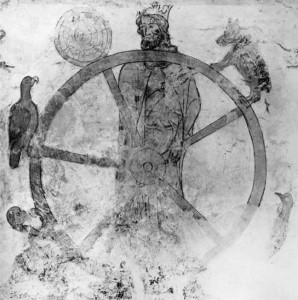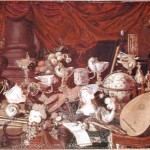Wheel of the Senses
Longthorpe Tower, Peterborough, Cambridgeshire, UK, ca. 1320–1340 ce
Animals have often been used to symbolize the senses in Western iconography.
One instance of this association is found in the mural in Longthorpe Tower, near
Peterborough, Cambridgeshire, England, which dates from the early fourteenth
century. The mural depicts a wheel with five beasts representing the five senses
positioned at the end of each of its spokes: the cock (lower right) stands for sight; the
boar for hearing; the monkey (lower left) for taste; the vulture for smell; and, a spider
in its web for touch. A king is shown behind the wheel, with his hand resting on one
of its spokes.
While the painting is clearly an allegory of the five senses, there remain many open
questions concerning the exact interpretation of its symbolism. Is the creature in the
lower right a cock, or perhaps a basilisk (with its deadly gaze)? Is the wheel a dynamic
or static image? What does the positioning of the senses on the wheel signify? Why a
king and what is his role? It could be that the positioning of the senses reflects a relative
ranking, with touch as the highest sense. It would appear that the king is emblematic
of the Aristotelian notion of the common sense, and that he exercises his dominion
(or judgment) over the beasts, the senses. To pursue these questions further see C.M.
Woolgar, The Five Senses in Late Medieval England (Yale University Press, 2006).
David Howes, Concordia University
Longthorpe Tower is managed by English Heritage.


